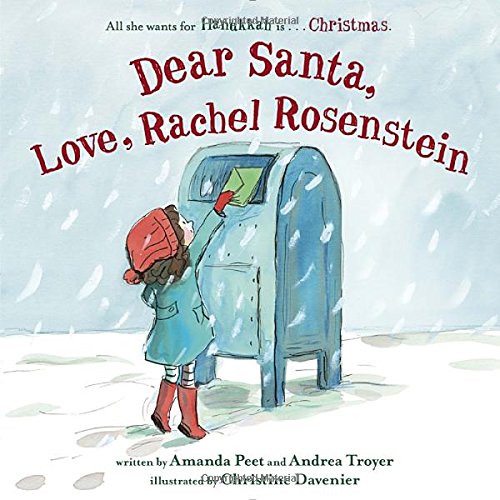
“All she wants for Hanukkah is…Christmas,” reads the tagline on the cover of Dear Santa, Love, Rachel Rosenstein. It seems that Rachel loves all the colorful decorations — she’s seen looking fondly back at them as her mother drags her by the hand. And of course, everyone on her block celebrates Christmas — except Rachel’s family. So one night Rachel writes a secret letter to Santa, promising cookies if he comes down her chimney (and pointing out she’s been good all year).
It’s a playful way to address a very real dilemma that Jewish parents with young children have to face every December, according to the book’s co-author, Amanda Peet. “A lot of Jewish parents seem very relieved and excited,” she told The Jewish Standard, “and then I think that a lot of people from our parents’ generation are also kind of tickled by it, because they remember feeling that way on their blocks growing up… I know my mother-in-law felt really touched by it, because that’s how she felt in her town where she grew up.”
I especially liked the colors in the book — lots of bright pastels, often emphasized by white backgrounds which can suggest a snowy street. (Illustrator Christine Davenier worked with Julie Andrews on her “Very Fairy Princess” series.) And it’s inspiring that despite its lighthearted story, some of book’s profits are being donated to a very serious non-profit, “Seeds of Peace” (founded in 1993 as a peace-building program for teenagers in Palestine, Israel, and Egypt, and other areas of conflict around the world). But best of all, like any good children’s picture book “Dear Santa, Love, Rachel Rosenstein” has a thoughtful message that’s honoring a child’s feelings, and making sure they know that they’re not alone
The book includes a sincere description of celebrating Shabbat, and acknowledges that “Being Jewish was fun most of the time. It meant you got to hunt for the afikomen on Passover, blow the shofar on Rosh Hashanah, and get a present a day for all eight days of Hanukkah — not to mention as many latkes as you could eat.” The book’s dramatic climax comes, of course, on December 24th. Rachel has created Christmas stockings for her family’s fireplace, strings of popcorn, and a big sign that says “I love you, Santa!” (And she even presses chocolate chips into latkes, then leaves them out with a glass of milk…)
“The Rosensteins were ready for Christmas,” the narrator writes, and Rachel anxiously stays up late, “listening for the clip-clop of Santa’s reindeer on the roof.” But will Santa make an appearance? I hope this isn’t a spoiler, but the answer is…. no. The next morning her father takes Rachel, who’s very disappointed, to an empty park drawn with bare, twiggy trees and covered with snow.
But then the family eats at a Chinese restaurant, and it’s there that Rachel sees some friends from her class at school. There’s an Indian girl and a Chinese boy — who celebrate Diwali and Chinese New Year, respectively. (And who also don’t celebrate Christmas.) Here’s where the book delivers its message of reassurance. “Rachel realized: when there were so many great holidays in the world, why feel so bad about one little old day like Christmas?”
Although as a final joke, the narrator concedes Rachel might feel “a tiny bit bad” — as she sees four Christian kids walking down the street with enormous presents wrapped with red bows…